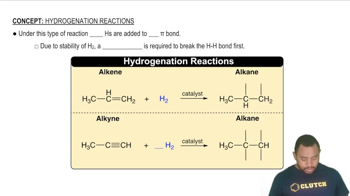In each pair of compounds, pick the one with the higher boiling point. Explain your reasoning. b. CH3OH or CH3SH
Ch.12 - Liquids, Solids & Intermolecular Forces
Chapter 12, Problem 48b
In each pair of compounds, pick the one with the higher vapor pressure at a given temperature. Explain your reasoning. b. CH3CH2CH2OH or CH3OH
 Verified step by step guidance
Verified step by step guidance1
Step 1: Understand that vapor pressure is a measure of the tendency of a substance to transition into the gas phase. It is influenced by the strength of the intermolecular forces within the substance. The weaker the intermolecular forces, the higher the vapor pressure.
Step 2: Identify the types of intermolecular forces in each compound. Both CH3CH2CH2OH (propanol) and CH3OH (methanol) are alcohols, and thus have hydrogen bonding, dipole-dipole interactions, and London dispersion forces.
Step 3: Compare the strength of the intermolecular forces in each compound. Both compounds have similar types of intermolecular forces, but propanol has a longer carbon chain, which increases the strength of its London dispersion forces.
Step 4: Recall that substances with stronger intermolecular forces have lower vapor pressures. Therefore, methanol, with its shorter carbon chain and weaker London dispersion forces, will have a higher vapor pressure than propanol.
Step 5: Conclude that CH3OH (methanol) has a higher vapor pressure at a given temperature than CH3CH2CH2OH (propanol) due to its weaker intermolecular forces.

Verified video answer for a similar problem:
This video solution was recommended by our tutors as helpful for the problem above.
Video duration:
1mWas this helpful?
Key Concepts
Here are the essential concepts you must grasp in order to answer the question correctly.
Vapor Pressure
Vapor pressure is the pressure exerted by a vapor in equilibrium with its liquid or solid phase at a given temperature. It reflects the tendency of molecules to escape from the liquid phase into the gas phase. Compounds with weaker intermolecular forces generally exhibit higher vapor pressures because their molecules can more easily enter the vapor phase.
Recommended video:
Guided course

Raoult's Law and Vapor Pressure
Intermolecular Forces
Intermolecular forces are the forces of attraction or repulsion between neighboring particles (atoms, molecules, or ions). These forces include hydrogen bonding, dipole-dipole interactions, and London dispersion forces. Stronger intermolecular forces result in lower vapor pressures, as more energy is required for molecules to escape into the vapor phase.
Recommended video:
Guided course

Intermolecular vs Intramolecular Forces
Hydrogen Bonding
Hydrogen bonding is a specific type of strong dipole-dipole interaction that occurs when hydrogen is bonded to highly electronegative atoms like oxygen, nitrogen, or fluorine. In the context of alcohols, such as CH3CH2CH2OH and CH3OH, hydrogen bonding significantly influences their physical properties, including vapor pressure. The presence of more hydrogen bonds typically leads to lower vapor pressure due to the increased energy required to break these interactions.
Recommended video:
Guided course

Hydrogenation Reactions
Related Practice
Textbook Question
Textbook Question
In each pair of compounds, pick the one with the higher vapor pressure at a given temperature. Explain your reasoning. a. CH4 or CH3Cl c. CH3OH or H2CO
Textbook Question
Determine whether each pair of compounds forms a homogeneous solution when combined. For those that form homogeneous solutions, indicate the type of forces that are involved. a. CCl4 and H2O b. KCl and H2O c. Br2 and CCl4
Textbook Question
Determine whether each pair of compounds forms a homogeneous solution when combined. For those that form homogeneous solutions, indicate the type of forces that are involved. d. CH3CH2OH and H2O
Textbook Question
Which compound would you expect to have greater surface tension: acetone [(CH3)2CO] or water (H2O)? Explain.
